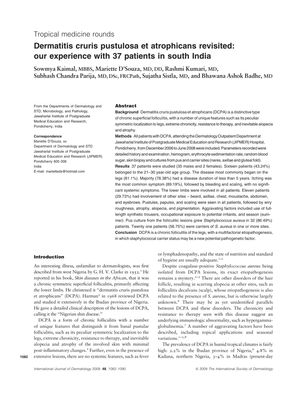Dermatitis Cruris Pustulosa Et Atrophicans Revisited: Our Experience With 37 Patients In South India
September 2009
in “
International Journal of Dermatology
”

TLDR DCPA is a chronic leg infection often related to Staphylococcus aureus, affecting mostly young men in India.
The study focused on Dermatitis cruris pustulosa et atrophicans (DCPA), a chronic superficial folliculitis primarily affecting the legs, which leads to alopecia and atrophy. It included 37 patients (35 males and 2 females) from the Dermatology Outpatient Department at JIPMER Hospital in Pondicherry, India, between December 2006 and June 2008. The majority of patients were in the 21–30 year age group and had the disease for less than 5 years. Common symptoms included itching (89.19%), bleeding, and scaling, with the lower limbs being affected in all cases. Additional sites like the beard, axillae, chest, moustache, abdomen, and eyebrows were involved in 29.73% of patients. Factors exacerbating the condition were synthetic trousers, occupational irritants, and summer season. Staphylococcus aureus was cultured from the lesions in 86.49% of patients, and 56.75% were carriers of S. aureus at various body sites. The study concluded that DCPA is a chronic leg folliculitis with a multifactorial cause, where staphylococcal carrier status might be a significant pathogenetic factor.



